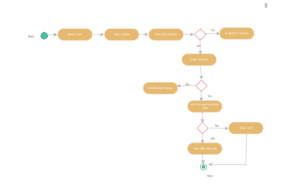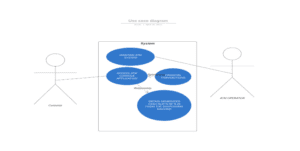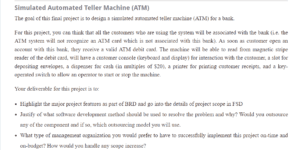Simulated Automated Teller Machine
Simulated ATM Bank Machine Project Design
The business requirement document should outline the goals and expectations of the automated teller machine design specification simulation. The goals of the ATM machine simulation should explain the features that are essential for the design analysis for project implementation and design. The Business Requirements Document (BRD) should provide a detailed description of the system and document extensively the customers’ needs and expectations for the automated teller machines (ATM) for the system analysis. Furthermore, the functional specification document (FSD) should give a conceptual overview of the functionality of the system, a step-by-step outline of the functionality of the system design flow, and how functional parameters are classified within the ATM systems (Cheng et al., 2011).
An ATM system is a simulated machine that commercial banks use to help customers process their transactions via an ATM machine. The bank users access their bank accounts via a magnetic stripe card that’s encoded with the user’s information within the magnetic stripe. The magnetic stripe contains a unique identification code that’s connected to the banking financial servers and is essentially vital for retrieving vital users’ financial information (Subramanian, 2010, p. 15).
The Purpose of the ATM System
The project aims to implement and simulate the real-world functional requirement for the automated teller machine and a design system that will conceptually allow all the customers to access the financial records within the ATM systems (Cheng et al., 2011).
Highlight the major project features as part of BRD and go into the details of project scope in FSD.
Scope of The Project
The scope of the project is the implementation of an ATM system that synchronously communicates with the bank core network systems through an auxiliary established Application Programming Interface API (The bank API can be in the form of SOAP APIs – XML format and RESTful APIs that essentially in JSON compliant format).
Project User Specification
The intended users for the ATM core banking systems are composed of the following users:
- Bank customers interact with the bank ATM systems and execute financial transactions from the core banking through the simulated ATM machines.
- ATM system maintainer: regularly updates and connects to the systems to maintain its functionality and keep the system up-to-date.
The major features of the ATM system should include:
- Opening accounts. When the customers open accounts with the bank, they’re automatically given ATM cards to essentially allow them to communicate with the banking servers to obtain the generic financial information from the core enterprise servers.
- Cash transaction processing. The customers can perform financial transactions through the simulated console (keyboard and display monitor) that facilitates interactions with the customers and, thus, the cash dispenser that automatically generates cash in the form of $20. The console should perform the following financial components.
- Cash withdrawal. Facilitates cash withdrawal. Allow the customers to withdraw subsequently a large amount of cash transactions from the ATM display machine.
- Cash deposit. Allow customers to deposit cash to the financial ATM machines in real-time instances.
- The automated console machine should allow the customers to check their balances and pay bills within the customized ATM console machines.
Functional requirement specification for the ATM machine
- The authorization should start when the users input their cards into the machine
The customers access the console, and the bank first checks the validity of the card’s magnetic stripe and confirms if the card belongs to the bank.
Inputs
Reads the serial numbers and requests for the user passcode to validate the user credentials and thus allows them access to their account details.
- Initiation of the customers’ transaction requests.
Determine the kinds of transactions and facilitate customer transaction requests in real time.
For withdrawal requests, the authorization of the amount to be withdrawn is requested through the portal (Enter the amount of money to be requested through the console application)
Output
The withdrawal request commences, and thereafter, the dispenser generates the requested amounts in the bill of $ 20.
Justify of what software development method should be used to resolve the problem and why? Would you outsource any of the component and if so, which outsourcing model you will use.
The preferred software development method is the Agile software development method because it can minimize the risks associated with software development. The merits of implementing Agile software development design help develop the systems in iterations that contain mini-increments of the new functionality constraints to effectively develop higher-quality software components (Liu et al., 2010). The variations of Agile software development include scrum, extreme programming that’s essentially important in developing the console applications in mini-increment (prototyping) to allow the development of fully functional systems. The importance of implementing agile software development is because of the following fundamental reasons:
- Agile software development allows team collaborations to achieve the stipulated tasks for a given project specifications.
- Helps to effectively handle change management
- Implements real-time testing of the final products and makes appropriate decisions regarding the product changes to help achieve a better product that’s essentially aligned with end-user goals and objectives.
The outsourced features in developing the ATM systems will be outsourcing the ATM dispenser slots. The main reason for outsourcing the machines will be to save costs that are essentially used for the development from scratch, lessen the development time, and implement an offshore location-based strategy (outsourcing outside your country) to access the wider pool of international talents, allows faster upscaling of the business segments and reduces the financial budgets that are generated from a higher workforce (Obana & Hanakawa, 2017).
What type of management organization you would prefer to have to successfully implement this project on-time and on-budget? How would you handle any scope increase?
For an effective project implementation within the financial, and budgetary constraints and timely implementation, the organization must adopt a well-structured organizational policy that facilitates an easier decision-making process. The management strategy to be implemented should advocate a hierarchy-based divisional organizational strategy that’s essential for facilitating a top-down chain of commands and facilitating responsibility and authority within the organizational dynamics. The strategy can help create the appropriate business atmosphere for the attainment of the business goals and effectively manage the business’s daily operations. The management style can further help handle the project scope on budget and on time (the management style keeps the employees motivated to achieve the stipulated goals).
Detail design document using UML diagram (you can choose which models to choose)
The bank ATM systems UML diagram model should clearly depict an abstract representation of the system’s main actors, roles, actions, artifacts, and documents to help the system’s stakeholders understand the system implementation much more easily and help document the system flow in a simplistic manner.

UML Diagram
(designed from creately.com)
Detail test cases for the project based on your design document
The test case analysis provides a conceptual flow analysis for the ATM card systems with a detailed analysis of the ATM console applications and their attributes.

Test Case Analysis
Conclusion
For the effective delivery of the project scope and the deliverables, the organization must implement an elaborate implementation plan that breaks down the project milestones into sequences that make it easier to break down the project, helps to achieve the goals in a timely manner, and facilitates advanced strategic goal alignment. The implementation plan should be elaborate and contain detailed information on the following features (the outline/objectives of the project, the responsibility work breakdown matrix, the definition of the project metrics, and the project contingency plans for successful project implementations). The importance of the implementation plan is to keep everyone on track toward achieving project scope deliverables and provide a better understanding of the project goals.
References
Cheng, P., Chen, Y., & Zou, Y. (2011). Analysis on knowledge flow mechanism of software requirement development. 2011 International Conference on E-Business and E-Government (ICEE). https://doi.org/10.1109/icebeg.2011.5882781
Liu, Y., Ma, Z., & Shao, W. (2010). Integrating non-functional requirement modeling into model driven development method. 2010 Asia Pacific Software Engineering Conference. https://doi.org/10.1109/apsec.2010.21
Obana, M., & Hanakawa, N. (2017). Software development business model for top level process with competitive bidding – Is requirement analysis the unpaid work? Proceedings of the Seventh International Symposium on Business Modeling and Software Design. https://doi.org/10.5220/0006528601730179
Subramanian, N. (2010). Software architecture interference – An important non-functional requirement for software ecosystems. International Journal of Software Architecture, 1(1), 15-16. https://doi.org/10.5308/2153-8409.001.01.008
Systems project management. (2013). Reconstructing Project Management, 27-51. https://doi.org/10.1002/9781118536698.ch3
ORDER A PLAGIARISM-FREE PAPER HERE
We’ll write everything from scratch
Question 
Simulated Automated Teller Machine (ATM)
The goal of this final project is to design a simulated automated teller machine (ATM) for a bank.

Simulated Automated Teller Machine
For this project, you can think that all the customers who are using the system will be associated with the bank (i.e. the ATM system will not recognize an ATM card which is not associated with this bank). As soon as customer open an account with this bank, they receive a valid ATM debit card. The machine will be able to read from magnetic stripe reader of the debit card, will have a customer console (keyboard and display) for interaction with the customer, a slot for depositing envelopes, a dispenser for cash (in multiples of $20), a printer for printing customer receipts, and a key-operated switch to allow an operator to start or stop the machine.
Your deliverable for this project is to:
- Highlight the major project features as part of BRD and go into the details of project scope in FSD
- Justify of what software development method should be used to resolve the problem and why? Would you outsource any of the component and if so, which outsourcing model you will use.
- What type of management organization you would prefer to have to successfully implement this project on-time and on-budget? How would you handle any scope increase?
- Detail design document using UML diagram (you can choose which models to choose)
- Detail test cases for the project based on your design document
- Conclusion (preferably an implantation/communication plan/other recommendations)